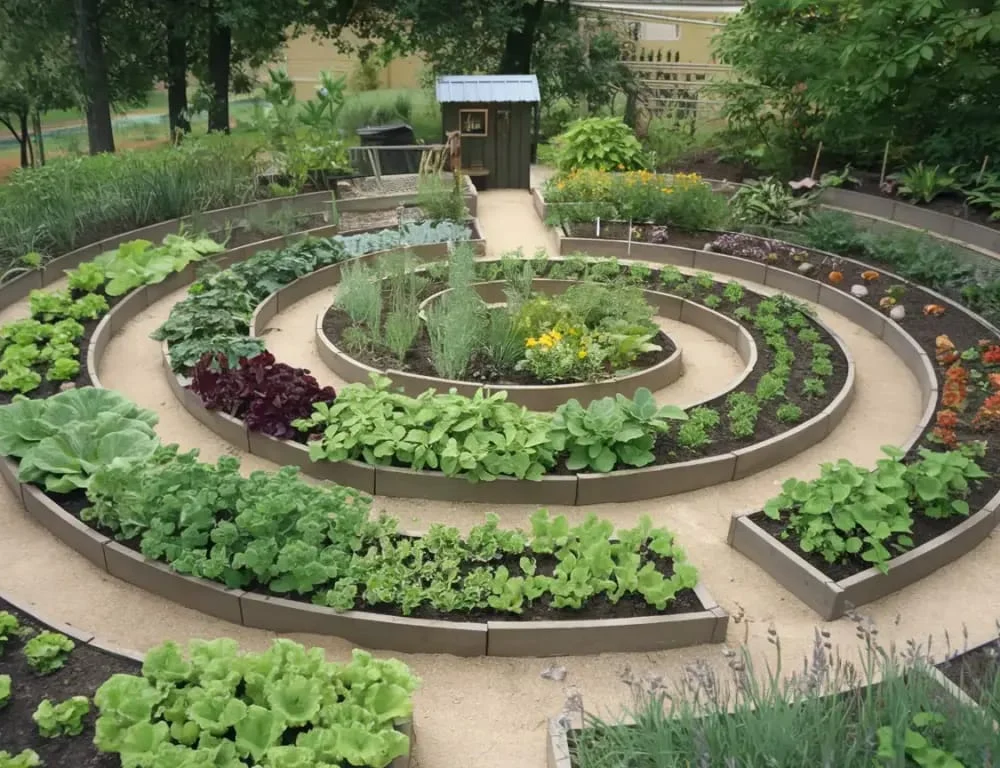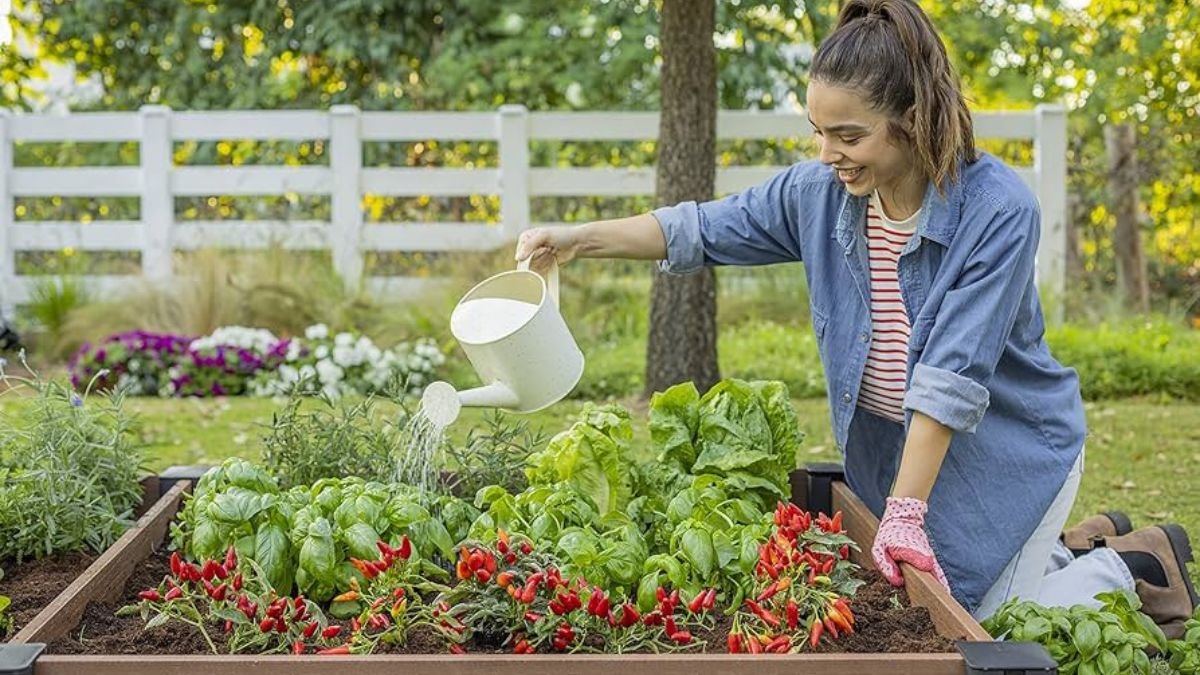Are you struggling to grow a thriving garden in poor soil or limited space? Raised garden beds might be your solution. Whether you’re a seasoned gardener or just starting, creating a raised bed can transform your outdoor space and make gardening easier.
From simple designs for beginners to advanced projects for pros, this guide offers 16 DIY raised bed ideas tailored to every skill level. Say goodbye to back pain, weeds, and uneven growth; these practical, stylish solutions will help you grow more with less effort. Ready to build the garden of your dreams? Let’s get started!
16 Stunning DIY Raised Bed Ideas for Every Skill Level (Build Your Dream Garden)

1. Grid-Style Compartment Garden

Wooden compartments transform this garden into a highly organized growing space. Each square houses different vegetables and herbs, creating a practical planting system that maximizes every inch. Bold red tomatoes and radishes add splashes of color against the various shades of green.
The rich soil provides nutrients for leafy greens, herbs, and root vegetables growing side by side. You can easily access each section without disturbing neighboring plants. This design works wonderfully for small spaces as it separates plants that might compete for resources. Companion planting becomes simple when crops have designated areas.
The wooden borders prevent soil erosion while keeping pathways clean. Water stays where it is needed rather than running off. The overall aesthetic combines practicality with visual appeal, making garden maintenance less overwhelming. This form also helps you track which plants thrive in which locations for future planning.
2. Arched Trellis Walkway Garden

Metal arches create a stunning walkway between these raised beds, offering beauty and function. The curved black metal frames will soon support climbing plants, turning this garden path into a green tunnel. Newly planted beds flank both sides, with fresh soil ready for the growing season.
Sunlight streams through the open arrangement, guaranteeing that plants get adequate light while providing structure. This setup allows for comfortable access between beds without bending or stretching. The gravel pathway prevents mud and maintains clean footing even after watering. The substantial height of these beds reduces back strain during planting and harvesting.
You can grow vertically on the arches while utilizing the beds for ground crops. The metal construction ensures durability through changing seasons and weather conditions. This structure merges art with agriculture, making your garden a focal point rather than just a growing space. The surrounding landscape complements the geometric shapes, creating harmony between the garden and its environment.
3. Vertical Growing Powerhouse

This wooden raised bed showcases the magic of vertical gardening techniques. Tall trellises support climbing plants like cucumbers and beans, demonstrating how to grow upward when ground space is limited. Vibrant lettuce and purple cabbage create a colorful patchwork at ground level.
The visible carrot tops hint at the root vegetables growing beneath the soil. Wire mesh panels provide sturdy support for climbing vegetables, keeping them off the ground and away from pests. Fresh cucumbers hang freely, making harvesting simple and keeping produce clean. The strategic placement of different plant heights ensures all crops receive adequate sunlight.
This garden strategy maximizes growing space in a modest footprint. Wooden sides contain the soil while allowing proper drainage. The thoughtful arrangement includes companion plants that benefit each other. This approach works particularly well against fences or walls in small yards. The abundant yield from this compact space proves that extensive land isn’t necessary for productive gardening.
4. Polytunnel Raised Bed Garden

This ingenious greenhouse setup extends the growing season dramatically. Long raised wooden beds run parallel under a protective polytunnel covering. The transparent material creates a microclimate that shields plants from harsh weather, allowing sunlight to penetrate.
Climbing vegetables reach upward on trellises, making use of vertical space. Leafy greens thrive in a controlled environment, growing larger and faster than they would outdoors. Bright red tomatoes ripen on the vine, showcasing the productivity of this protected growing space. The central pathway provides easy access to all areas of the garden.
The configuration prevents soil compaction and improves drainage. Early spring and late fall harvests become possible with this setup. Temperature regulation inside the tunnel creates better-growing conditions for heat-loving crops. Water conservation improves as evaporation slows in the enclosed space. This approach combines the benefits of raised beds with greenhouse growing techniques.
The wooden structure offers durability, while the plastic covering can be removed or replaced as needed. You can grow exotic or sensitive plants that wouldn’t survive in your climate without this protection.
5. Spiral Garden Masterpiece

Concentric raised beds create a mesmerizing spiral pattern in this garden design. The circular layout uses space efficiently while creating distinct growing zones. Herbs occupy the center ring, surrounded by vegetables of various heights and colors. Metal edging contains the soil while defining the clean pathways between growing areas.
The spiral design allows you to reach plants from multiple angles without stepping on growing areas. Different sun exposures throughout the day benefit various plants as shadows shift. Water naturally flows from higher to lower sections, creating micro-irrigation zones. This layout turns a functional garden into an artistic landscape feature. The center serves as a focal point, drawing the eye inward.
Colorful lettuce varieties contrast beautifully with dark purple vegetables. Gravel pathways provide drainage and prevent mud during wet seasons. The small shed in the background offers convenient storage for garden tools. This plan works especially well on sloped land, turning challenging terrain into an advantage.
6. Urban Space-Saving Garden System

This clever garden setup maximizes limited urban space with multiple growing zones. Square wooden beds sit on gravel, creating clean pathways between planting areas. Vibrant lettuce fills the center box while herbs and vegetables thrive in the surrounding beds. Vertical growing options abound, with wall-mounted shelving units holding colorful trays of greens.
Red plants climb along wall-mounted strings, adding visual interest and utilizing every inch of the fence. Metal shelving units stack plants upward, turning unused vertical space into productive growing areas. The wooden pergola provides structure for climbing vines while defining the garden space. The gravel underneath keeps maintenance low and prevents mud after watering.
This layout works wonders for small patios, courtyards, or side yards where ground space comes at a premium. Fresh herbs and salad greens stay within easy reach for kitchen harvesting. The combination of horizontal and vertical elements creates garden layers that catch the eye while producing substantial yields. Small-space gardeners will appreciate how this layout transforms fence lines and walls into productive growing zones.
7. Herb Spiral Garden With Companion Planting

This pretty garden features a classical spiral herb design surrounded by complementary raised beds. Lush green herbs wind upward in circular patterns, creating microclimates for different plant varieties. Lively orange calendula flowers attract beneficial insects while adding warm color contrast to the cool lavender patches. The purple cabbage makes a dramatic focal point with its architectural leaves and rich coloring.
Wooden borders contain the growing areas while allowing easy navigation through straw-covered pathways. Tall trellises along the back wall support vigorous climbing plants, adding height to the garden. Various herbs grow at different levels, making harvesting straightforward while creating visual interest. The spiral design naturally creates zones with different moisture levels, allowing drought-tolerant herbs at the top and water-loving varieties below.
Bright purple lavender stands out against chartreuse herbs, showcasing how edible gardens can be visually stunning. This garden combines beauty and function, becoming a peaceful retreat that engages all senses. The plants help control pests naturally through companion planting principles. You could recreate this design in varying sizes depending on the available space.
8. Keyhole Garden With Composting Center

This innovative garden combines raised beds with a built-in composting system. The circular design features wedge-shaped growing sections radiating from a central blue compost bin. Straw-lined pathways allow easy access to all planting zones without soil compaction. Bright red tomatoes grow alongside sunny yellow cherry tomatoes, creating vibrant spots against the greenery.
The blue wooden compost circle stands out as both a functional element and an artistic centerpiece. Fresh lettuce and herbs occupy separate sections, making crop rotation and garden planning straightforward. This keyhole design minimizes water usage as nutrients flow outward from the central compost area. The raised wooden borders keep soil contained while improving drainage and preventing back strain during gardening tasks.
Rectangular beds in the background add more growing space and variety to the garden layout. The mulched pathways suppress weeds while slowly breaking down to add nutrients to the soil. Heat-loving crops thrive in the south-facing sections, while shade-tolerant plants grow happily on the northern side. This garden establishes how thoughtful design can create sustainable growing systems that reduce waste and water usage.
9. Multi-Level Community Garden

These wooden raised beds showcase smart planning for maximum harvest in a community garden setting. Light-colored wood frames create organized growing sections filled with thriving vegetables. Bright cabbage and lettuce varieties form living mosaics of green in varying shades and textures. Vibrant strawberries bring splashes of red against the dark soil, adding visual excitement.
The mini greenhouse cover protects tender seedlings from harsh weather and extends the growing season. Staggered bed heights create visual interest while allowing different soil depths for various root systems. Background arches hint at trellising options for climbing plants in the larger garden complex. The golden evening light highlights the fresh produce, emphasizing the garden’s productivity.
Mulched pathways between beds provide clean access regardless of weather conditions. This setup works beautifully for community gardens where the organization helps multiple gardeners work harmoniously. The substantial harvest visible in each bed demonstrates the effectiveness of raised garden systems. Early morning or late afternoon watering becomes easy with the accessible design. Garden planning and rotation become simpler with clearly defined growing zones. This arrangement balances aesthetics with practical growing needs.
10. Poolside Elevated Garden Trio

These handsome elevated garden beds create a stunning border between the pool area and the fence line. Three wooden planters stand on sturdy legs, filled with colorful vegetables and flowers. White stones spread beneath the structures add visual appeal while providing drainage. The wooden frames sit at waist height, making gardening comfortable without bending or kneeling.
Young plants thrive in these boxes, bringing life to what would otherwise be an unused space. Smart positioning against the fence maximizes sun exposure while creating a living privacy screen. The raised design keeps soil away from pool splashes and prevents runoff during heavy rains.
Fresh cedar lumber gives these structures a natural resistance to decay. You could build these in a weekend with basic tools and lumber from any home improvement store. Thoughtful spacing between each planter allows easy access for watering and harvesting from all sides.
11. Rustic Metal and Wood Garden Boxes

These stylish raised beds combine galvanized metal with warm wood framing for a country-chic garden solution. Lush kale and vibrant pepper plants thrive in these generous growing spaces. The metal sides reflect sunlight to warm soil on cool mornings, while the wooden caps create comfortable seating edges for gardening tasks.
Each box features a unique height, allowing for different root depths and planting needs. An old barn and vintage truck provide a picturesque backdrop to these functional growing containers. The corrugated metal siding prevents soil erosion and helps maintain consistent moisture levels.
Wooden corner posts anchor each structure securely to the ground. Heat-loving plants like tomatoes and peppers flourish in the center bed, while leafy greens fill another. This design blends agricultural functionality with rustic charm. The combination of materials creates long-lasting structures that resist rot and rust.
12. Modern Galvanized Garden Grid

This organized garden layout features multiple galvanized metal beds arranged in a thoughtful grid pattern. Wooden trim caps each metal container, creating clean lines and comfortable edges for maintenance work. Various crops grow at different stages; leafy greens are ready for harvest in one bed, and young seedlings are emerging in another.
Gravel pathways between beds allow easy access while preventing mud during rainy weather. The metal sides heat up during sunny days, extending the growing season for heat-loving plants. Tall wooden posts at the rear suggest future trellising for climbing vegetables. The brightness of the metal contrasts beautifully with the rich greens of the growing plants.
Each bed serves a specific purpose in this well-planned garden ecosystem. The layout maximizes growing space while maintaining accessibility from all angles. Strong and weather-resistant materials ensure that these beds will last through many growing seasons. The methodical arrangement brings visual symmetry to productive gardening.
13. Classic Cedar Garden Frame

This straightforward cedar raised bed sits on a bed of decorative gravel for excellent drainage. Young vegetable seedlings have just been planted, their bright green leaves contrasting with the dark soil. The simple rectangular design fits beautifully in this spacious backyard setting. Thick cedar boards create substantial walls that will hold up for many seasons.
The clean lines complement the manicured lawn and showcase the growing plants. Gravel surrounding the frame prevents grass from encroaching and makes maintenance easier. The neutral wood tones blend harmoniously with the natural landscape. This affordable design requires minimal tools and woodworking skills to create.
The raised soil level warms quickly in spring, allowing earlier planting than ground-level gardens. Deep soil volume accommodates root vegetables and long-season crops. This versatile garden box could work equally well for flowers, herbs, or vegetables. The simple form creates a beautiful focal point in the yard without competing with the surrounding landscape.
14. Mint-Colored Garden Grid System

Bright teal boxes transform this backyard into a functional growing space. Several raised beds painted in cheerful mint green create an organized layout against the wooden fence backdrop. The boxes sit at various heights, allowing for different soil depths depending on plant needs.
Small seedlings and young vegetables sprout throughout the beds, promising a bountiful harvest as they mature. Colorful bunting hangs along the fence, adding a festive touch to this productive garden. A small greenhouse structure stands in the background, extending the growing season for tender plants. This layout makes excellent use of available space by sectioning off different growing areas.
You can easily recreate this design using simple lumber and exterior paint. The height of these beds reduces bending while gardening, making this an excellent option for gardeners with mobility concerns. Wooden stakes support climbing plants, showing thoughtful planning for vertical growth.
15. Natural Cedar Tiered Garden Boxes

Cedar planks create stunning interlocking raised beds in this compact garden space. The natural wood tones contrast beautifully with the vibrant greenery spilling over the edges. Flowers in bold yellow, orange, and purple bloom alongside leafy vegetables, showing how edibles and ornamentals can grow together harmoniously.
Multiple beds at different levels create visual interest and allow for planting zones based on sun exposure and water needs. Wooden lattice fencing provides privacy while allowing filtered light to reach the plants. This design maximizes growing space in a small urban yard, turning a narrow side area into a productive garden.
The untreated cedar will weather to a silver-gray over time, adding character to the garden. You can build these boxes using basic woodworking skills and standard lumber. The staggered layout creates natural pathways between planting areas, making garden maintenance easier and more enjoyable.
16. Elevated Trellis Garden Station

This clever design combines a raised wooden planter with a built-in trellis system. Raw cedar boards form the main structure, divided into growing sections for different plants. The sturdy post anchors both the planter and overhead beam, creating a stable framework for hanging baskets and climbing plants.
Turquoise paint accents the bottom edge, adding a pop of color against the natural wood. Young seedlings have just been planted, with plenty of space to grow and spread. The entire unit stands on its legs, keeping it elevated from the ground for easier access and protection from ground pests. Hanging baskets dangle from the overhead beam, utilizing vertical space for additional planting opportunities.
This plan works wonderfully for small spaces like patios or alongside houses. The thoughtful height puts plants at a comfortable working level, reducing strain on your back and knees. The strong structure confirms this garden bed will last for years of growing seasons.

